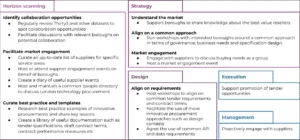An iterative approach to procuring innovatively
We’ve been working with the team at PUBLIC to develop practical guidance on the different tools, methods, approaches, and processes which boroughs can use to bring more innovation into each stage of the procurement lifecycle. All with the end goal of achieving better technology procurement outcomes for the public sector.
The result is LOTI’s Innovation in Procurement Toolkit, which is available here.
Whilst the guidance will help boroughs to improve their processes and to better engage with the market, we’re keen to go one step further. We want to put into practice the advice outlined in the guidance and to make use of the power of the LOTI collective to initiate a snowball effect that could make public sector procurement an exemplar of good procurement practice.
And it’s this that I’ll focus on in this post.
Experimenting with new ways of working
Over the next three weeks, LOTI boroughs will come together to experiment with applying the guidance and trialling a new way of working on their procurement of housing services systems, an opportunity highlighted by our City Tools dashboard which we launched in November 2019.
Whilst service priorities and challenges will be largely similar across all boroughs, there will be many moving parts, differing ambitions, and appetites for risk, different technical architecture setups, and requirements.
However, we hope this will be an opportunity to test whether collaborative procurement is possible. And if so:
- What are the right conditions beyond willingness?
- How can we move at pace and maintain accountability?
- Whether boroughs can align on technical requirements, key contract clauses, etc.
Let’s be clear – this work is not about boroughs jointly procuring technology. We’re aware of existing mechanisms that can help with that. Instead what we’d like to see is whether we can create a formula for improving procurements that can be applied to any future tender.
Getting the ball rolling
We’re starting small.
In the toolkit, you’ll see there’s advice and guidance on common problematic areas as highlighted by LOTI boroughs, from horizon scanning to strategy, design, execution, and contract management.

Horizon Scanning
In this initial phase of the work, led by the team at PUBLIC, we’ll be selecting key elements from the above areas that will help us most in the challenging area of housing services – a market currently dominated by large legacy suppliers.
At the other end of the spectrum are start-ups and scale-ups, that are developing more innovative solutions, but that often struggle to enter the public sector. This is partly because of the public sector’s perception of these solutions as risky. These solutions are sometimes early prototypes and therefore cannot respond to all the complex needs of a particular service. LOTI’s ambition is to dispel any potential misconceptions about new technologies and give boroughs the confidence to experiment and learn from a collaborative effort.
Our aim is that through this process, boroughs are better informed about new innovations in the housing space. So, we’re planning to kick off with a horizon scanning session to shed light on current innovators in the housing market and any existing good procurement practice in the public sector.
Strategy
We also know that long and often complex tender specifications and endless technical requirements make it harder for SMEs to access public sector procurement opportunities. It also makes it more difficult for the public sector to get value for money, especially when often there’s a small number of (typically large suppliers) that can meet those requirements.
So our next step will be all about the specifics: aligning on the user and business needs, tender specifications, agreeing roles and responsibilities of the different boroughs as well as timelines. Whilst we anticipate service needs and outcomes for all users will be largely similar across all boroughs, we know we’ll have to potentially work with different timelines. This will make it harder for all interested boroughs to get involved in this phase, so we’re counting on a few to actively participate, with many others providing insight, knowledge, and experience to this part of our journey.
Design and Execution
The final round is where we’ll be deciding on the most suitable common route to market. Our desired outcome for this process is that boroughs align on a procurement approach.
To affect any change commercially, particularly where a small number of suppliers have had a stronghold of the market for many years will require a critical mass of participants, relentless engagement, and consistency of message. What we hope this process will do is to enable boroughs to approach suppliers with a single voice. What we’re keen to find out is the extent to which this approach will influence the suppliers in question.
To affect any change from an innovation point of view, particularly at a time when few SMEs have solutions that meet the full end-to-end housing service provision needs, will be a much longer journey and we know this is no quick fix.
These first steps will help us learn what elements are more important for boroughs, what some of the constraints are (beyond what we already know), what the non-negotiables are and what we need to keep persevering with.
Creating an avalanche of activity
In this incremental approach, we wish to practice the behaviours associated with collaborative ways of working, building on existing engagement with boroughs and suppliers.
We’re starting with housing services because of LOTI boroughs’ interest and imminent opportunity in this area and believe that this focused approach is likely to yield better results. Our intention is to build on this momentum and based on PUBLIC’s recommendations also informed by boroughs, LOTI will be planning a series of activities, as outlined in the diagram below.

Going forward, our plan is to create a forum that meets regularly to discuss broader challenges, priorities, and opportunities for boroughs to collaborate on. A key enabler of making this happen and continuing to build on what we’re starting now is reliable information on contract end dates, which we’re capturing on our Thirty3 platform. Spotting these opportunities early enough is critical and we need boroughs to share their contract and technology data, as my colleague Jay has outlined in this blog.
We’ll be learning from this process and adapting our approach to innovative procurement. We’ve sketched out a few ways in which we could support boroughs to do so. No doubt, the lessons, and insights from our current workshops will help us to create the next iteration of this approach.
Look out for further updates on this project, here.
Genta Hajri

